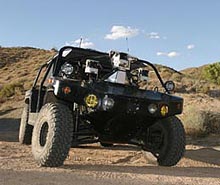
The DARPA Challenge: Build a car that can drive itself across 175 miles of desert with unpaved roads, ditches, berms, sandy ground, standing water, rocks and boulders, narrow underpasses, construction equipment, concrete safety rails, power line towers, barbed wire fences, cattle guards and maybe even tank traps.
Impossible? Probably. But a team of Cornell engineering students is in California trying, as contestants in the 2005 DARPA Challenge. They suspect they won’t succeed, but they don’t think anyone else will either. In last year’s competition, the most successful car only went 7.5 miles before breaking down.
Don’t forget! DARPA helped spawn the Internet.
It’s an event that has “wait till next year!” built in, according to Matt Grimm ’06, leader of the business team that supports the engineers. DARPA (the Defense Advanced Research Projects Administration) has offered a $2 million prize for the builders of the vehicle that can complete the course in the shortest time (with a 10-hour maximum). The goal is to create autonomous vehicles that can transport supplies or perform reconnaissance in dangerous places — like Iraqi highways — without endangering troops. Beyond that, the technology has applications in disaster response and space exploration. By making the task hard enough to require several years of trial and error, Grimm said, DARPA will get thoroughly tested ideas. But, he adds, Cornell is going in with a design that could succeed.
The course will start and end in Primm, Nev., about 50 miles south of Las Vegas on the California-Nevada border, but DARPA will not reveal the route until the beginning of the test. Then, each team will be given a CD with the route laid out as a series of waypoints identified by latitude and longitude, precise down to 15 centimeters. The vehicle must figure out for itself how to get from one waypoint to the next, avoiding natural and man-made obstacles. The only command the team is allowed to give the vehicle is “start.”
The Cornell team started with one of the most rugged off-road vehicles available, a Spider Light Strike Vehicle, manufactured and donated by Singapore Technologies. The all-terrain vehicle is built to military specifications and tested in combat, so it is much better able to cope with off-road conditions than an ordinary SUV or truck. The team figures that even if their sophisticated control system can’t avoid an obstacle, the Spider might just be able to drive over it.
In order to complete the course in 10 hours, the vehicle will have to average 17.5 mph. But since it may spend part of its journey moving very slowly over rough terrain, it will sometimes have to hit 35 to 40 mph.
And it gets Geeks to go outdoors!















What about Carnegie Mellon’s Red Team?
http://www.redteamracing.org/
According to the 2004 results, the “winning” vehicle travelled only 7.4 miles before it went off course in a section of switchbacks, caught fire, and had to be shut off remotely.
Think about it–driving a vehicle is a hard to learn skill for humans (do you remember being taught to drive a car?). That skill will probably have to be developed in a robot using AI techniques.
Paul, what, pray tell, don’t you understand about the word “spawned”? Oh, and engineers back then didn’t mind crediting other folks outside ARPA — like Baran [who eventually ended up consulting] and Davies.
Last year, Team TerraMax caught my attention. They’re back and talking a good game:
http://www.terramax.com/media/video_gallery.cfm
Go Team Ensco!
2 guys I work with are participants on the team. They have a great vehicle. Got an email update today from them, they’re having a blast in CA
Heck, I drive CA freeways…..I’d SWEAR more than half the SUV’s are unmanned….can’t see the drivers. They don’t act like they are intelligently piloted.
(Why is it always that 4’9″ women drive those things? They can’t even SEE over the steering wheels.)
Meetsy,
A few years ago I was riding with a group of four or so people, when we saw the hilarious sight of watching a small to midsize four-door sedan seemingly driver-less going down the highway. From behind and even approaching from the adjacent lane, no sign of life in there. Only when we got *directly* beside it did a head finally appear– not a woman, just a little short guy. It was one of those you-had-to-be-there moments. Not that I am making fun of little short guys– I am a little short guy, relatively speaking.
Mike,
I got interested in this stuff a few years back because I owned stock in a company that makes the turbine for a robot vehicle called the spinner. You can read more about Darpa’s interests in this spinner article:
http://www.popsci.com/popsci/automotivetech/50a33bcc2eb84010vgnvcm1000004eecbccdrcrd.html
Why do I get the feeling that the bubbas on the body shop next door can atually do that but the army is preferring the overpaid nerds who tend to have the arrogant tendencies of a mid level manager?